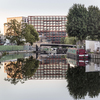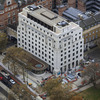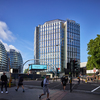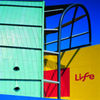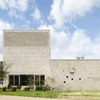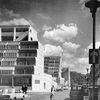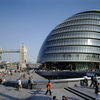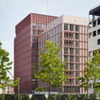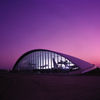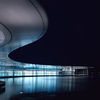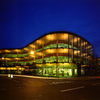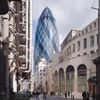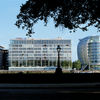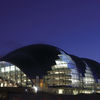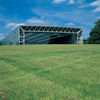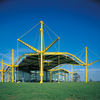Bloomberg London
Subscribe now to instantly view this image
Subscribe to the Architects’ Journal (AJ) for instant access to the AJ Buildings Library, an online database of nearly 2,000 exemplar buildings in photographs, plans, elevations and details.
Already a subscriber? Sign in
The project had a budget of £1 billion
Jim Stephenson Download Original
Foster + Partners’ £1 billion European HQ for business news giant Bloomberg is ambitious, accomplished and lavish.
The fins, 117 in total, are the building’s way of ‘breathing’. A section opens or closes depending on exterior conditions to allow air to flow into the building while keeping external noise to a minimum, as well as filtering incoming air. Chunky stone corners and shear walls form part of the sandstone façade, with muscular poché sections fitted with thermal doors allowing air to circulate through the structure.
Inside, the office floor plans are deep, and between the visually demanding integrated ceiling, (the petals act as acoustic attenuators, light reflectors and a means of cooling via snaking piping behind them) and the large exterior fins, certain areas feel a little more closed-in than the plan would suggest, although the steel structure’s triangular grid reduces the number of columns in the space.
The desks, reportedly based on one Bloomberg himself uses, slot together to form clusters, with the occasional introduction of a round ‘impromptu meeting’ table. allowing access to services.
A vast atrium/breakout/refreshment space looks up to a huge skylight, through which all of the air drawn into the building is exhausted. Beneath this a twisting trefoil staircase ascends ramp-like through the centre of the building, shallow step by shallow step. This all sits above the ground-level ‘Vortex’, a foyer space formed by curved timber shells. Additional spaces include an auditorium, a dining area and a news broadcast studio.
Structural solutions were driven by the complex contingencies of a site that has been redeveloped over many generations. These included an unprecedented reuse of about 8,000 piles installed in the late 1950s, the presence of a 3m-diameter Victorian sewer, prevention of damage to the adjacent Grade I-listed St Stephen’s Church by Sir Christopher Wren, significant archaeological remains, construction of a new underground link 20m beneath our buildings and the Temple of Mithras. The engineering response unites and neutralises these constraints with a hybrid piled raft to liberate the superstructure.
Data
- Begun: Oct 2012
- Completed: Oct 2017
- Floor area: 65,500m2
- Sectors: Office, Public realm
- Procurement: Direct commission
- CO2 Emissions: 13.7kg/m2/year
- Address: Cannon Street, London, EC4N 6JJ, United Kingdom
Professional Team 
- Architect: Foster + Partners
- Client: Bloomberg
- Structural engineer: AKT II
- M&E consultant: Sweco
- Quantity surveyor/cost consultant: AECOM
- Project manager: Stanhope
- Approval building inspector: City of London
- Main contractor: Sir Robert McAlpine
- Landscape architect: Charles Funke Associates
- Lighting consultant: Tillotson
- Security consultant: QCIC
- Computer consultant: PTS Consulting
- Wireless consultant: iWireless
- Media set consultants: Jack Morton Worldwide
- Local projects consultant: Mithras Fit-out
- Art Consultant: Nancy Rosen
- Drylining: Optimise
- Cleaning consultant: Reef Associates
- Acoustics: Sandy Brown Associates
- Planning consultant: DP9


























